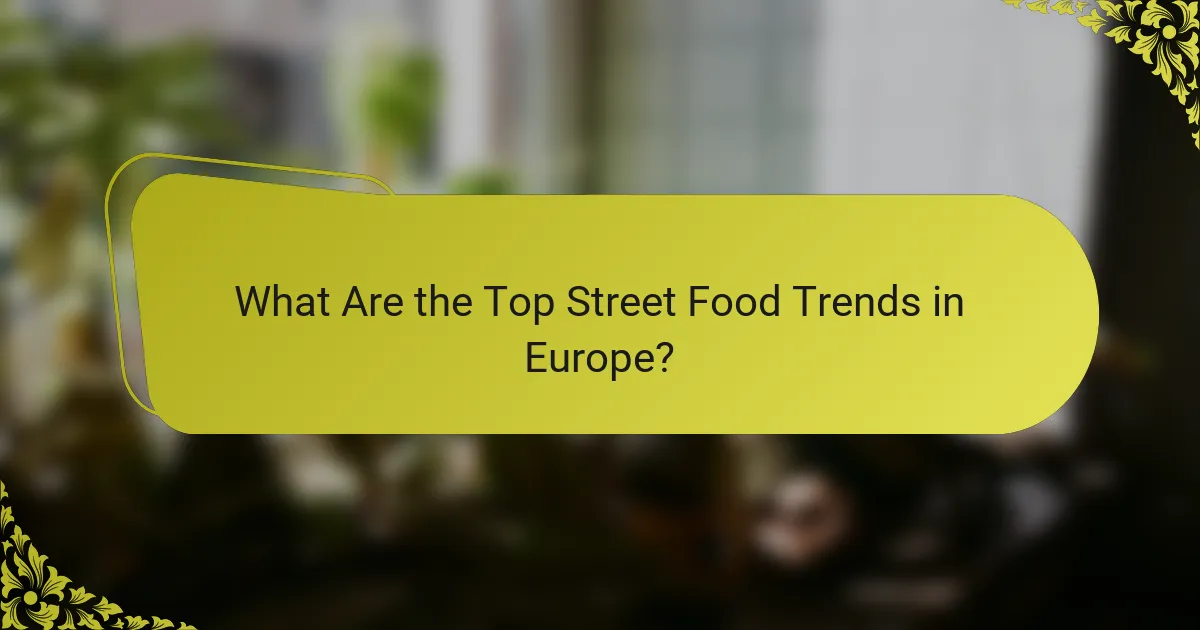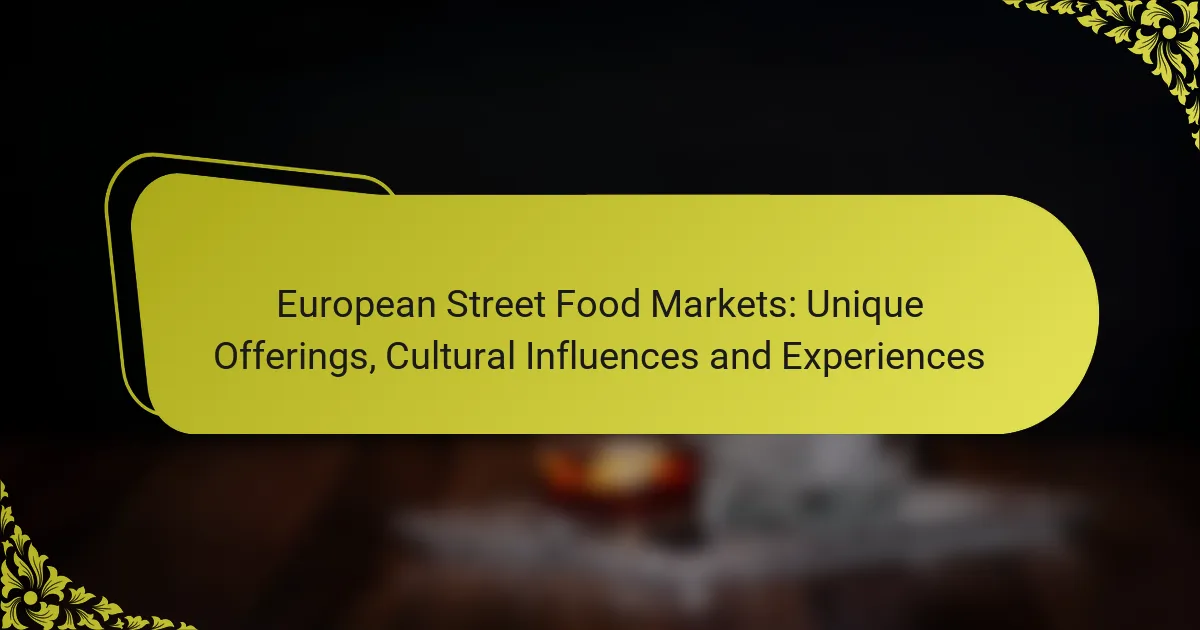European street food markets are vibrant cultural hubs that showcase a rich tapestry of local flavors and culinary traditions. Offering a diverse array of unique dishes, these markets allow visitors to experience the region’s seasonal ingredients and innovative fusions, all while immersing themselves in the local lifestyle. The blend of cultural influences further enhances the street food experience, making each market a delightful exploration of history and community.

What Are the Best European Street Food Markets?
The best European street food markets offer a vibrant mix of local flavors, cultural influences, and unique culinary experiences. These markets are not just places to eat; they are cultural hubs where visitors can immerse themselves in the local lifestyle and traditions.
Borough Market, London
Borough Market is one of London’s oldest and most renowned food markets, known for its diverse selection of gourmet street food. Visitors can find everything from artisanal cheeses to freshly baked pastries and international dishes, reflecting the city’s multicultural vibe.
Open six days a week, the market features a variety of stalls run by passionate vendors. It’s advisable to visit during weekdays for a less crowded experience, allowing you to savor the food and engage with the vendors more easily.
Mercato Centrale, Florence
Mercato Centrale is a vibrant food market located in the heart of Florence, showcasing the best of Tuscan cuisine. The market is divided into two levels: the ground floor is dedicated to fresh produce, meats, and cheeses, while the upper level features numerous food stalls offering ready-to-eat meals.
When visiting, try local specialties like ribollita or lampredotto, a traditional Florentine sandwich. The market is open daily, making it a great spot for lunch or to pick up local ingredients for dinner.
La Boqueria, Barcelona
La Boqueria is a bustling market situated just off La Rambla in Barcelona, famous for its colorful stalls and fresh produce. This market is a paradise for food lovers, offering a wide array of tapas, seafood, and local delicacies.
Be sure to sample the jamón ibérico and fresh fruit juices available at various stalls. Arriving early in the morning can help you avoid crowds and experience the market at its liveliest.
Markthalle Neun, Berlin
Markthalle Neun is a historic market in Berlin that has transformed into a trendy food destination. It features a mix of permanent vendors and rotating pop-up stalls, offering everything from traditional German dishes to international street food.
Visit on Thursdays for the Street Food Thursday event, where you can taste a variety of global cuisines. The market emphasizes sustainability, so many vendors focus on local and organic ingredients.
Street Food Market, Amsterdam
The Street Food Market in Amsterdam is a lively gathering spot for food enthusiasts, featuring a rotating selection of food trucks and stalls. This market celebrates the diversity of Amsterdam’s culinary scene, with options ranging from Dutch classics to international flavors.
Check the market’s schedule, as it operates on specific days and locations. Don’t miss trying the traditional stroopwafels or herring, which are local favorites that capture the essence of Dutch street food.

What Unique Offerings Can You Find?
European street food markets feature a diverse array of unique offerings that reflect the local culture and culinary traditions. From traditional dishes to innovative fusions, these markets provide an exciting way to experience regional flavors and seasonal ingredients.
Local delicacies
Local delicacies are a highlight of European street food markets, showcasing the rich culinary heritage of each region. For instance, in Italy, you might find arancini, which are stuffed rice balls, while in Spain, churros served with thick chocolate are a popular treat. Each country offers its own signature dishes that are often prepared using traditional methods.
When exploring local delicacies, consider trying items that are unique to the area you are visiting. This not only supports local vendors but also gives you a taste of authentic flavors that you may not find elsewhere.
Fusion cuisine
Fusion cuisine in European street food markets blends traditional recipes with international influences, creating innovative dishes that surprise and delight. For example, you might encounter a taco filled with Italian ingredients or a sushi roll that incorporates Mediterranean flavors. This culinary creativity reflects the multicultural nature of many European cities.
When sampling fusion cuisine, be open to unexpected combinations. While some pairings may seem unusual, they often result in delicious and memorable experiences. Look for vendors who highlight their unique fusion offerings to ensure you try the best of what’s available.
Seasonal specialties
Seasonal specialties are another key aspect of European street food markets, with vendors often featuring dishes that highlight fresh, local ingredients. For instance, during autumn, you may find pumpkin-based dishes or hearty stews, while summer markets might showcase fresh salads and grilled vegetables. These seasonal offerings not only taste better but also support local agriculture.
To make the most of your experience, visit markets during peak seasons for specific ingredients. This way, you can enjoy dishes that are at their freshest and most flavorful, enhancing your overall culinary adventure.

How Do Cultural Influences Shape Street Food?
Cultural influences shape street food by blending diverse culinary traditions, ingredients, and cooking techniques. This fusion creates unique dishes that reflect the history and preferences of different communities.
Historical migration patterns
Historical migration patterns significantly impact street food offerings, as they introduce new flavors and cooking styles. For instance, the arrival of Middle Eastern immigrants in Europe has popularized dishes like falafel and shawarma, which are now staples in many urban markets.
These migrations often lead to a culinary exchange, where local ingredients are combined with traditional recipes from migrants’ home countries. This results in innovative dishes that celebrate both heritage and local tastes.
Regional ingredients
Regional ingredients play a crucial role in defining street food, as they determine the flavors and textures of the dishes. For example, in Italy, street food often features fresh produce, cheeses, and cured meats sourced from local farms, enhancing the authenticity of dishes like arancini and porchetta.
Using locally available ingredients not only supports regional agriculture but also allows street food vendors to create seasonal menus that reflect the changing tastes throughout the year.
Traditional cooking methods
Traditional cooking methods contribute to the authenticity and appeal of street food. Techniques such as grilling, frying, and slow-cooking are often passed down through generations, preserving cultural heritage. In Spain, for example, the use of wood-fired grills for preparing chorizo and other meats adds a distinctive flavor that cannot be replicated by modern methods.
Street food vendors who embrace these traditional methods often attract customers seeking genuine culinary experiences. However, they must also balance these practices with food safety regulations to ensure the health of their patrons.

What Are the Top Street Food Trends in Europe?
The top street food trends in Europe reflect a growing demand for diverse culinary experiences, focusing on quality, sustainability, and innovation. Key trends include plant-based options, gourmet street food, and the rise of food trucks and pop-ups, each offering unique flavors and cultural influences.
Plant-based options
Plant-based street food is gaining popularity across Europe as more consumers seek healthier and sustainable eating choices. Vendors are creatively using ingredients like jackfruit, lentils, and various vegetables to craft delicious dishes that appeal to both vegans and meat-eaters alike.
Popular plant-based offerings include vegan burgers, falafel wraps, and innovative desserts made from natural ingredients. Cities like Berlin and London are particularly known for their vibrant plant-based street food scenes, with numerous stalls dedicated to meat-free options.
Gourmet street food
Gourmet street food elevates traditional street fare by incorporating high-quality ingredients and culinary techniques. This trend often features fusion dishes that blend flavors from different cultures, creating unique and memorable eating experiences.
Examples of gourmet street food include truffle fries, lobster rolls, and artisanal tacos. Events like food festivals often showcase these gourmet offerings, allowing vendors to attract food enthusiasts looking for something special.
Food trucks and pop-ups
Food trucks and pop-up stalls have transformed the street food landscape in Europe, providing flexibility and creativity for chefs and entrepreneurs. These mobile kitchens allow vendors to test new concepts and reach diverse audiences without the overhead of a traditional restaurant.
Many cities, such as Paris and Barcelona, host regular food truck gatherings, where visitors can sample a variety of cuisines in one location. This trend encourages culinary experimentation and fosters a sense of community among food lovers.

How to Choose the Right Street Food Market?
Choosing the right street food market involves considering location, vendor variety, and reviews. These factors will help ensure a satisfying culinary experience that reflects the local culture and offerings.
Consider location
The location of a street food market can significantly impact your experience. Markets situated in popular tourist areas may offer a broader range of international cuisines, while those in local neighborhoods often provide authentic regional dishes.
When selecting a market, think about accessibility and safety. Look for markets that are easily reachable by public transport or within walking distance from your accommodation. Additionally, consider visiting during peak hours for a livelier atmosphere.
Evaluate vendor variety
A diverse selection of vendors can enhance your street food experience. Markets with a mix of cuisines allow you to sample different flavors and dishes, catering to various dietary preferences and restrictions.
Check if the market features local specialties alongside international options. A good balance between established vendors and newcomers can provide both reliability and excitement in your food choices.
Check for reviews
Reading reviews can help you gauge the quality and popularity of a street food market. Look for feedback on food quality, vendor friendliness, and overall atmosphere to make an informed decision.
Websites and apps like TripAdvisor or Yelp can provide insights from fellow food enthusiasts. Pay attention to recent reviews, as they often reflect current vendor offerings and market conditions.
